Part
One: The First Edition
Reading the second half of Edgar
Rice Burroughs’ 24 Tarzan books can leave even a Burroughs fan a little
jaded. I’ve done it many times and get that feeling … until I come to Tarzan
and “The Foreign Legion”. It’s a story that is so different, so
deep, and so violent, that it commands my attention each time I read it.
The trait that makes “Foreign
Legion” unique among all of Burroughs’ works is the author’s feeling
of “presence.” The reader gets the distinct feeling (at least I do) that
Edgar Rice Burroughs is one of the story’s cast of characters. Much of
his narration is presented with such emotion that it could have been said
by one of the members of the “Foreign Legion” — Jerry, Corrie, Shrimp,
Sarina, Bubonovitch, etc.
And why couldn’t Edgar Rice Burroughs
be an unnamed character in the novel? The events in the story appear to
take place at about the same time that the author is known to have written
them — between June 10 and September 11, 1944. We know from his wartime
newspaper articles that Burroughs, as a war correspondent, visited American
soldiers on islands in the Pacific and that he saw Japanese prisoners there.
In a February 1942 article in the Honolulu Star-Bulletin, Burroughs
described being a passenger on a “flying fortress,” along with an Associated
Press photographer.
“I do not know at what altitude
we flew; but as I stood between two open gun ports, holding to both because
of the roughness of the air, the sea, far below, appeared a solid mass
of dark blue ice flecked with snow — the whitecaps that did not appear
to move, from my Olympian vantage point.”
If Burroughs were allowed to ride
along as an observer in that flight, he also could have been permitted
in his official role as a war correspondent to be aboard “The Lovely Lady”
when it took off on a reconnaissance flight in April 1944. He then could
have successfully bailed out of the airplane later that day and joined
Tarzan, Lucas, Bubonovitch, and Rosetti on the ground to begin their adventures
on Sumatra.
(Another clue that Burroughs was
on scene with the others in Sumatra is the narrator’s habitual use of the
terms “Jap” and “Japs,” as did Tarzan and the three American flyers. More
on that point later.)
The
“Hate the Japs” Theme
One basic theme of Tarzan
and “The Foreign Legion” that differentiates it from all other
Burroughs Tarzan stories is the recurring theme of hatred, in both voice
and action, toward the Japanese race.
Corrie van der Meer, a Dutch girl
who joins the “Legion” after they free her from Japanese captivity, twice
stated her hatred explicitly.
“I hate all Japs. I hate the
‘poor dumb things who shoot at us and whom we shoot at.’ I am not as philosophical
as you and Tarzan. I want to hate them. I often reproach myself because
I think I am not hating bitterly enough … You never saw your mother hounded
to death and your father bayoneted by those yellow beasts. If you had and
didn’t hate them you wouldn’t be fit to call yourself a man.” (Chapter
8)
“I believe that I shall be a
better woman for the very emotion he and Tarzan deplore — hate. I do not
mean petty hatreds. I mean a just hate—a grand hate that exalts. And for
the compensations it entails, such as loyalty to one’s country and one’s
comrades, the strong friendships and affection which are engendered by
a common, holy hate for a common enemy.” (Chapter 10)
Corrie rejected Tarzan’s and Jerry
Lucas’ refusals to hate. “That is just a heroic pose on the part of
fighting men,” she said. “When a Jap atrocity hits home, I’ll bet
they hate.” (Chapter 10)
Although Tarzan dismissed hatred
of the enemy as a meaningless emotion, note what Burroughs had the ape-man
do when he thought Japanese soldiers had killed pilot Jerry Lucas.
“When Tarzan had looked at the
wounded American … Tarzan was sure the wound was fatal. His anger against
the Japs flared, for he liked the young flier. Unnoticed by the others,
he swung into the trees and was off on the trail of the enemy.
“When the last officer went down,
the Japs began to run along the trail in the direction of their main camp.
They had had enough. But Tarzan had not. He followed them until all his
arrows were gone, each one embedded in the body of a Jap. The screaming
wounded were tearing arrows from backs and bellies. The silent dead were
left behind for the tigers and the wild dogs.” (Chapter 22)
Obviously, Tarzan felt some hate
for the enemy on that occasion, as did all the other members of the “Foreign
Legion.” Notice how the group reacted in the following situation.
“A moment later, a wounded Jap
shot the Dutchman who was trying to help him. Shortly thereafter there
were no wounded Japs.” (Chapter 22)
“Japs”
vs “Japanese”
Another way in which all members
of the “Foreign Legion” displayed their hatred for enemy soldiers was to
refer to them constantly with the racial slur of “Jap” or “Japs.” By my
count, Burroughs used the terms a whopping 201 times in Tarzan and
“The Foreign Legion”. Of those, over half, a total of 104, are
used in Burroughs’ narration. Tarzan is quoted using the terms 13 times.
Other disparaging terms the allied band assigned to the enemy soldiers
include “monkey-men,” “sub-men,” “devils,” “yellow-bellies,” “yellow beasts,”
“dumb things,” “Nip,” “yellow runt,” “yellow bastards,” “soulless creatures,”
and “bandy legged little men.”
Of course, Burroughs used all of
those disparaging terms in Tarzan and “The Foreign Legion”
when he was writing the book during the middle of a vast war against Japan
in which thousands upon thousands of American soldiers and sailors were
killed or wounded. In the December 7, 1941, Japanese attack on Pearl Harbor
(which Burroughs witnessed) 2,335 American service members were killed.
Between August 7, 1942, and February 9, 1943, 1,598 U.S. Marines and soldiers
died during the Battle of Guadalcanal. The invasion of the Pacific island
of Saipan in June-July, 1944 (while Burroughs was writing Tarzan
and “The Foreign Legion”), took the lives of another 3,400 Americans.
Historically, it’s to be expected that enemies, especially those who start
such wars, would be roundly and bitterly hated. (Iwo Jima with 6,140 Americans
killed and Okinawa with 12,000 more were still to come in 1945.)
Tarzan and “The Foreign Legion”,
as Edgar Rice Burroughs wrote it in1944, exists today as a prime example
of American war propaganda designed to increase fear and anger and harden
the country’s resolve to defeat Japan. However, the book’s power to accomplish
that purpose at the time was foiled when Tarzan and “The Foreign
Legion” remained unpublished until August 1947, a full two years
after the war with Japan ended. It wasn’t reprinted in paperback form until
1964.
Part
Two: ERB, Inc.’s Modified Edition
Several months ago, I received
a “heads-up” that in its upcoming edition of Tarzan and “The Foreign
Legion” Edgar Rice Burroughs, Inc., was going to make some changes
in Burroughs’ original text. Now, this type of thing was done way back
in the 1960s when Ballantine Books purged wording that it considered offensive
to blacks in some of their Tarzan paperbacks. However, it was so limited
that it never altered the events or tone of Burroughs’ stories. I wondered
now, though, if the changes in this new printing of Tarzan and “The
Foreign Legion” might soften the intensity of Burroughs’ original.
Therefore, when I received ERB,
Inc.’s shipment of the final four Tarzan books, I immediately read Bob
Zeuschner’s Foreword to see if he provided information on the changes in
the story’s text. Bob’s only comment on the issue is that “ … many of
the disparaging passages in this novel, which were acceptable during wartime
… have been gently modified to render them a bit less offensive in our
times.”
That sounded fair enough to me,
but to assess the merit of that conclusion, I opened to Chapter One of
both my first edition reading copy of Tarzan and “The Foreign Legion”
and ERB, Inc.’s new edition. Laying them side-by-side, I began a word-for-word
comparison of their texts. Here’s what I discovered.
First, since the person who marked
the changes to be made was not identified, here we’ll refer to him or her
as the “censor.” (Sounds like a harsh term, but I believe it fits here.)
The
Oxford Dictionary defines a “censor” as “an official who examines
material that is about to be released, such as books, movies, news, and
art, and suppresses any parts that are considered obscene, politically
unacceptable, or a threat to security.”
By far the greatest number of changes
in Burroughs original text involve the words “Jap” and “Japs.” It starts
in the book’s fourth paragraph, which begins with “And the Japs
came, and Hendrik van der Meer took to the hills.” The new edition
reads, “And the Japanese came, and Hendrik van der Meer took
to the hills.” You’ll notice that this sentence is part of the author’s
narration. The censor made this same change from “Jap” or “Japs”
to “Japanese” over 100 times in the ERB, Inc. edition, sometimes
twice in the same sentence, such as below.
“The natives had been warned
not to touch the Jap weapons that the whites had hidden in their
village, nor would they have dared so to arm themselves against the proscription
of the Japs, of whom they stood in mortal terror.”
(Chapter 19)
In the new edition, that becomes
…
“The natives had been warned
not to touch the Japanese weapons that the whites had hidden in
their village, nor would they have dared so to arm themselves against the
proscription of the Japanese, of whom they stood in mortal terror.”
On 26 other occasions, the words
“Jap” or “Japs” were replaced with terms other than “Japanese,”
such as “soldier” or “enemy.”
When it came to character dialogue
in the text, however, the censure was inconsistent. On 22 such occasions,
the substitution of “Japanese” for “Japs” continued, such
as when Tarzan tells his comrades:
“If you remain here, that Jap
relief may show up before I get back.”
(Chapter 14)
In the new edition, that becomes:
“If you remain here, the Japanese
relief may show up before I get back.”
In his first edition, Burroughs allowed Tarzan to use
the terms “Jap” or “Japs” over 30 times. In the new edition,
however, Tarzan never uses those terms. Usually they have been changed
to “Japanese,” and on other occasions to such words as “soldier(s)”
and “the enemy.”
(On one occasion, though, Tarzan is allowed in the new
edition to express his disgust of Japanese soldiers. When he believed his
friend Jerry Lucas had been killed in a fight with the enemy, an angry
Tarzan followed the retreating Japanese soldiers and attacked them with
his bow and arrows. After returning to the camp of his companions, Tarzan
describes the Japanese soldiers he attacked as follows: “Soulless creatures
in a panic of terror—living robots helpless without their masters. I was
careful to pick those off first.” That description appears in both
the first and new editions.)
Just to sum it up, Burroughs used
the terms “Jap” or “Japs” about 200 times in the first edition.
The ERB, Inc., censor changed three-quarters of them to “Japanese”
or some other general word. The near 50 times the censor left those slurs
in the text of the new edition, they were in character dialogue.
In the new edition, Burroughs’ narration
was completely cleansed of the terms “Jap” and “Japs.”
Other
Censored Terms
Other terms the censor judged offensive
to Japanese people and so were also removed from the first edition text
for ERB, Inc.’s new edition include “monkey-men,” “sub-men,” “yellow-bellies,”
“yellow beasts,” and “bandy legged little men.” Except for one use of
“yellow-bellies” in dialogue, the censor swapped out all of those terms
for non-offensive ones. The Japanese language also was belittled in the
first edition. It was described at times as “monkey-talk” and “jabbering.”
The censor traded out “monkey-talk” for “gibberish” once, but let the term
“jabbering” stand.
A few times, longer passages were
deleted with no replacement text. An example is the following narration
statement from early in the first edition (Chapter 1).
“They heard the voice of the
white man and the monkey jabber of the Japs, but they could not
make out what was said.”
It was changed to the following
statement in the new edition.
“They heard the voices of Van
der Meer and the soldiers, but they could not make out what was said.”
Another example is the following
first edition exchange between Tarzan and the Dutch guerrilla Kervyn van
Prins:
Tarzan: “Your little brown cousins
are coming. They are about two miles away.” Van Prins’ response:
“Pardon me, Sir, but they are not brown. The bastards are yellow.”
(Chapter 21)
In the new edition, the boldface
words above have been deleted.
Pilot Jerry Lucas made the following
statement in the first edition (Chapter 13):
“If we ever get back home, I’ll
bet we’ll do something about the damned Nips and krauts that’ll
keep’em from starting wars for a heck of a long time.”
The new ERB, Inc., edition deletes
the boldface phrase so that the statement reads:
“If we ever get back home, I’ll
bet we’ll do something that’ll keep’em from starting wars for a heck of
a long time.”
The first edition (Chapter 24) contains
the following text:
Bubonovitch was swearing softly
under his breath. “The goddam Japs. The yellow bastards.”
In the new edition, the boldface
sentence above was deleted.
The changes made above result in
reducing the first edition’s word count by 32 words. Not much, certainly,
but there is one example of the censor deleting a passage of text from
the first edition. While not particularly long, it is particularly interesting.
In Chapter 24 of the first edition, a Lovely Lady crewmember shares a statement
made by a famous author:
Bubonovitch recalled a verse from
Kipling:
She knifed me one night’ cause
I wished she was white,
An’ I learned about women from
’er.
The 24 words in boldface above were
deleted from the ERB, Inc. edition (p. 171)
Part
Three: The Censor’s Work and Its Impact
It’s time to summarize the total
number of changes made in the text of the first edition of Tarzan and
“The Foreign Legion” to create the final text of ERB, Inc.’s new edition
of that volume. By far the greatest number of changes involved removing
the words “Jap” or “Japs” from the first edition and replacing them with
another term, usually, but not always, “Japanese.” There were 150 such
changes. There were an additional 21 single-word replacements of other
words deemed offensive. Two examples are “monkey-men” and “sub-men.” The
total of “single-word” replacements, then, is 171. The deletion of four
phrases and the Kipling text brings the grand total of changes the censor
made from the first edition to create the new edition to 176.
Now we come to the crucial question.
What is the overall impact of all of the changes the censor made in the
original text? Put another way, are the texts of the first edition and
the ERB, Inc., edition rendered fundamentally different by the changes
made, or are the changes so benign that the average reader wouldn’t notice
the difference?
I can only answer for myself that
it is the former. Certainly, the storyline and basic events remain the
same in both editions. All the actors on stage play their assigned roles.
However, in the wings there is one person who plays a decidedly different
role in the story’s two versions. It’s Edgar Rice Burroughs. By his repeated
use of the terms “Jap” and “Japs” in his role as narrator in original text,
Burroughs provided the story a distinct anti-Japanese atmosphere, which
he infused in all of the story’s main characters. Hatred of the Japanese
soldiers is the basic theme and mood that underlies the entire original
story. Changing almost all of Burroughs’ uses of “Jap” and “Japs” in his
narration to the word “Japanese,” undercuts the entire premise of the story—a
story that he hoped would be read by his fellow Americans during that vicious
war 80 years ago.
First, since the person or persons who marked the changes
to be made was (or were) not identified, here we’ll refer to him or her
or them as the “censor.” (Sounds like a harsh term, but I believe it fits
here.) The Oxford Dictionary defines a “censor” as “an official
who examines material that is about to be released, such as books, movies,
news, and art, and suppresses any parts that are considered obscene, politically
unacceptable, or a threat to security:"
For readers who may be uneasy with
that theme which Burroughs purposely infused in Tarzan and “The Foreign
Legion” so long ago, there is now a sanitized version in the ERB,
Inc. edition that they will find less troubling to read. For me, the next
time I read Tarzan and “The Foreign Legion”, I will reach
again for my much-used first edition reading copy.
I do, however, have some praise
for the new ERB, Inc., hardback edition of Tarzan and “The Foreign
Legion”. It sure looks nice lined-up with the new editions of the
other 23 Tarzan novels in my office bookcase. I stare fondly at that particular
shelf everyday.
—the end—


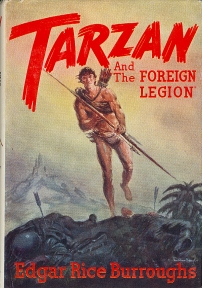
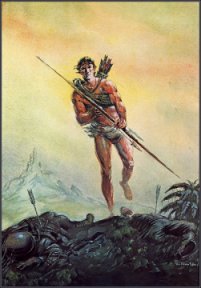
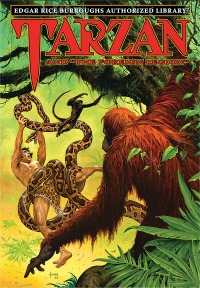
![]()
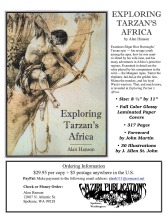 .
.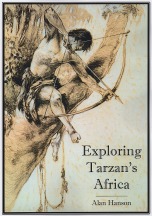 .
.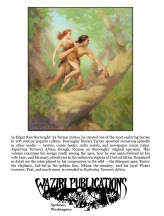
![]()
![]()
![]()
![]()
![]()
![]()

![]()